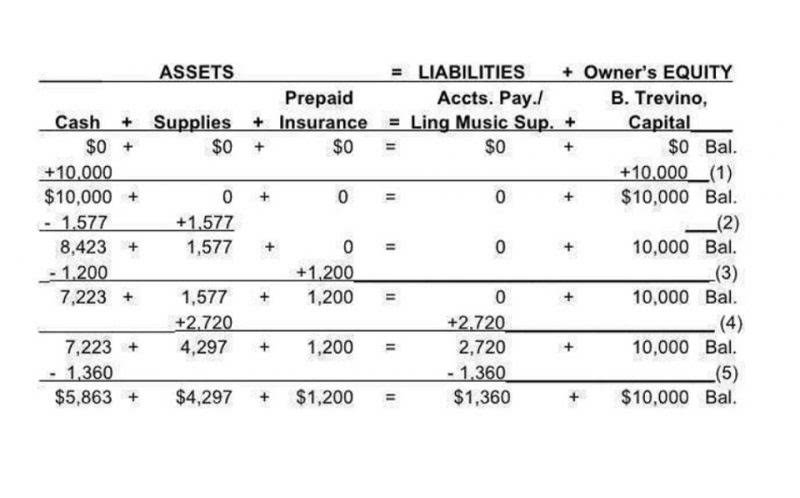
For example, Cost of Goods Sold is an expense caused by Sales. Insurance Expense, Wages Expense, Advertising Expense, Interest Expense are expenses matched with the period of time in the heading of the income statement. Under the accrual basis of accounting, the matching is NOT based on the date that the expenses are paid. Under the accrual basis of accounting, the Service Revenues account reports the fees earned by a company during the time period indicated in the heading of the income statement. Service Revenues include work completed whether or not it was billed.

What are some best practices for managing the normal balance of accounts?

In accounting, the capital account shows a business’s net worth at a specific point in time. For a sole proprietorship, it’s known as owner’s equity, and for a corporation, it’s called shareholders’ equity, reported in the bottom section of the balance sheet. Here’s a simple table to illustrate how a double-entry accounting system might work with normal balances. The same rules apply to all asset, liability, and capital accounts. This account is a non-operating or “other” expense for the cost of borrowed money or other credit. Salaries Expense will usually be an operating expense (as opposed to a nonoperating expense).
How Normal Balances Contribute to an Entity’s Financial Health
We will apply these rules and practice some more when we get to the actual recording process in later lessons. The terms originated from the Latin terms “debere” or “debitum” which means “what is due”, and “credere” or “creditum” which means “something entrusted or loaned”. Let’s recap which accounts have a Normal Debit Balance and which accounts have a Normal Credit Balance. Then, I’ll give you a couple of ways to remember which is which. We want to specifically keep track of Dividends in a separate account so we assign it a Normal Debit Balance. Liabilities (on the right of the equation, the credit side) have a Normal Credit Balance.
Revenue
If the normal balance of an account is debit, we shall record any increase in that account on the debit side and any decrease on the credit side. If, on the other hand, the normal balance of an account is credit, we shall record any increase in that account on the credit side and any decrease on the debit side. capital normal balance Every financial transaction affects an account related to assets, liabilities, or equity.
- Assets, expenses, and dividends or owner’s draws usually have a debit balance.
- The treasury stock account is a contra equity account that records a company’s share buybacks.
- In a T-account, their balances will be on the left side.
- If an account has a Normal Credit Balance, we’d expect that balance to appear in the Credit (right) side of a column.
- Because of the impact on Equity (it decreases), we assign a Normal Debit Balance.
- They highlight the importance of understanding journal entries in everyday business.
For assets and expenses, a debit increases their balance. For liabilities, revenues, and equities, a credit does the job. For instance, adding money to cash accounts is a debit.
- It’s what makes sure every financial statement is right, by showing how transactions change between debit and credit.
- Equity (what a company owes to its owner(s)) is on the right side of the Accounting Equation.
- This shows the resources used in businesses or personal finance activities.
- So for example there are contra expense accounts such as purchase returns, contra revenue accounts such as sales returns and contra asset accounts such as accumulated depreciation.
- The normal balance is the balance that the account normally sits in and it is the type of journal entry needed to increase the account.
- In contrast, liability and equity accounts have a credit balance.
A capital account in accounting refers to the financial assets that a company is able to spend in a given period. An equity account is the portion that shareholders would receive in a liquidation event—when a company’s assets are sold and its debts are paid off. Additional paid-in capital is the amount shareholders have paid into the company in excess of the stock’s par value. Retained earnings are the cumulative earnings of the company over time, minus dividends paid out to retained earnings balance sheet shareholders, that have been reinvested in the company’s ongoing business operations.

Visualizing Debits and Credits with T-Accounts

A current asset account that reports the amount of future rent expense that was paid in advance of the rental period. The amount reported on the balance sheet is the amount that has not yet been used or expired as of the balance sheet date. Costs that are matched with revenues on the income statement.

- The first part of knowing what to debit and what to credit in accounting is knowing the Normal Balance of each type of account.
- Because of the impact on Equity (it increases), we assign a Normal Credit Balance.
- An allowance granted to a customer who had purchased merchandise with a pricing error or other problem not involving the return of goods.
- And finally, we define what we call “normal balance”.
- Normal balance, as the term suggests, is simply the side where the balance of the account is normally found.
- If the customer purchased on credit, a sales allowance will involve a debit to Sales Allowances and a credit to Accounts Receivable.
It is possible for an account expected to have a normal balance as a debit to actually have a credit balance, and vice versa, but these situations should be in the minority. The normal account balance for many accounts are noted in the following exhibit. Asset accounts normally have debit balances, while liabilities and capital normally have credit balances. Income has a normal credit balance since it increases capital. On the other hand, expenses and withdrawals decrease capital, hence they normally have debit balances. As we wrap up our chat on accounting, it’s key to remember that knowing about normal balances is crucial.

